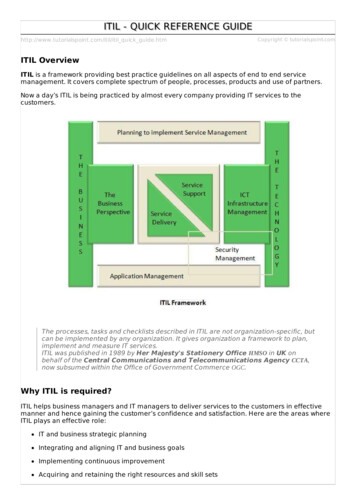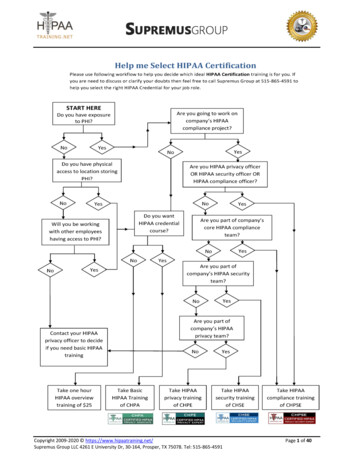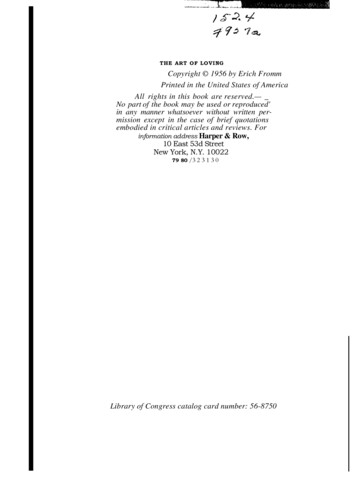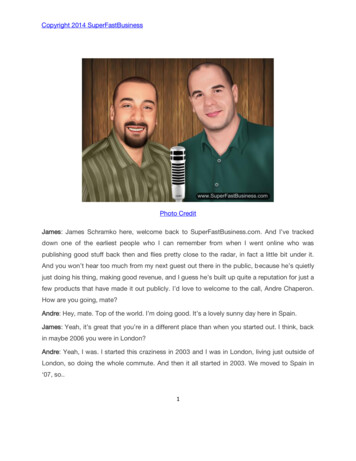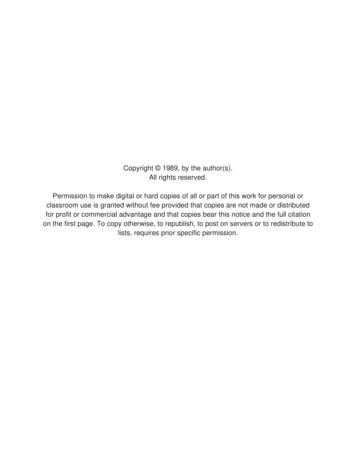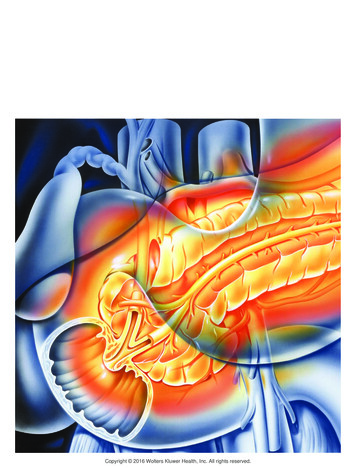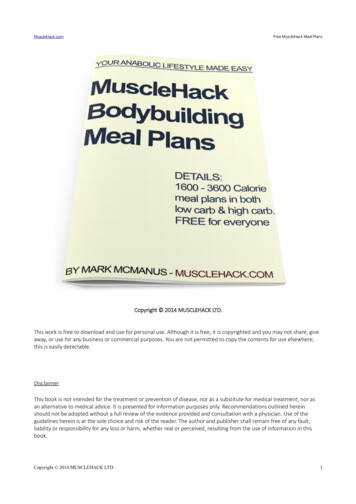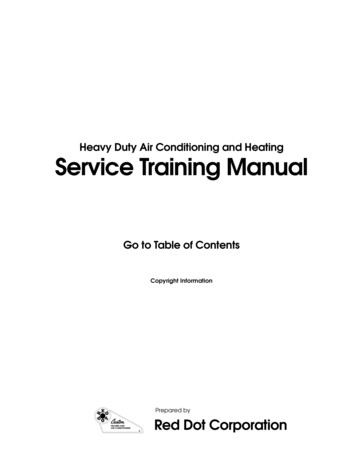
Transcription
Heavy Duty Air Conditioning and HeatingService Training ManualGo to Table of ContentsCopyright InformationPrepared byHEATERS ANDAIR CONDITIONERS Red Dot Corporation
Heavy Duty Air Conditioning and HeatingService Training ManualPublished byHEATERS ANDAIR CONDITIONERS RED DOT CORPORATION 495 Andover Park E. P.O. Box 58270 Seattle WA 98138-1270RED DOT CORPORATIONPublisherRed Dot Part No. RD-5-5900-0Trademarks: The terms CTC , Binary , Trinary , and TWIN TEMP areregistered trademarks of Red Dot Corporation. Freon is a registered trademark of DuPont Corporation. MITYVAC is a registered trademark of NewardEnterprises Incorporated.Disclaimer: The technical information and procedures described in this publication have been obtained from the most reliable sources available. The publisher assumes the data is accurate and current at the time of publication anddoes not accept any liability for errors, omissions or the correctness of contentsor procedures described herein.Copyright: No part of this work may be reproduced or used in any form or byany means—graphic, recording, taping, or information storage and retrievalsystems—without written permission of the publisher and copyright holder.Second EditionCopyright 1993 by RED DOT CORPORATION—All rights reserved.
Table of ContentsTable of Contents .1-3Introduction. Intro-11Chapter 2Chapter 3Chapter 4Chapter 5Chapter 6Chapter 7Chapter 8Chapter 9Chapter 10Chapter 11Chapter 12ChapterAir Conditioning / Heating Function . 1-1Overview of System Operation .2-1Heater Components and Controls .3-1Air Conditioner Components .4-1System Controls .5-1Service Tools and Their Use .6-1Inspection and Maintenance–without gauges . 7-1Troubleshooting & Service Procedures . 8-1Refrigerants .9-1Component Repair or Replacement . 10-1Typical HVAC Systems and Components . 11-1Retrofitting an R-12 System .12-1Glossary . i-1Figure Index . ii-1Subject Index. iii-1Go to Copyright Information
IntroductionThis manual has been designed and written for your use. Take your timereading it. Study the illustrations, charts and photos. Figure 1 shows a typicalHVAC system (heating, ventilating, air conditioning) installed.The illustration is cut away so you can see component locations. All of themain components are labeled, connected together and positioned approximately as they appear in the vehicle. These components may differ from onecab to another. There could be other system devices for safety or perhapssleeper cab comfort.Figure 1The illustration shows atypical HVAC system within-cab components mountedon the fire wall. The mainsystem components arenoted in this illustration.DEFROSTER DUCTBLOWER TION LINEREFRIGERANTDISCHARGE LINECOMPRESSORHEATER COREMAGNETICCLUTCHEXPANSIONVALVE (TXV)COOLANTLINE (RETURN)COOLANT(WATER) VALVECOOLANT LINESUPPLYSIGHT GLASSBINARY OR TRINARY SWITCHRECEIVERDRIERREFRIGERANTLIQUID LINESGo to Table of Contents - IndexWATER PUMPFAN CLUTCHRADIATOR MOUNTEDCONDENSEROR GRILLDENSERIntro-1
IntroductionFigure 2CONDENSER WITHRECEIVER DRIERTypical off-road installation.REFRIGERANT DISCHARGE LINEA/C VENTSMAGNETIC CLUTCHCOMPRESSORREFRIGERANT SUCTION LINEBLOWER AND MOTORREFRIGERANT LIQUID LINEEVAPORATOR WITHEXPANSION BLOCKAND THERMOSTATThe Table of Contents lists the chapters and gives you their page locations.There are two separate indexes at the back of the manual. The Figure Indexdescribes each figure with its number and page location. The Subject Index willhelp you locate each subject covered in the manual.Each chapter begins by listing the main topics you will want to learn andremember. Key points are repeated for your review at the close of most chapters. The illustrations are explained and parts are labeled where necessary foreasy identification. You should feel free to make notes in this manual andunderline or circle anything that is important to you.Our purpose is to give you knowledge, and confidence in your ability to work onheavy duty air conditioning and heating systems. Your working speed andtrouble shooting skills will improve with experience.The systems we cover here for heavy duty heating and air conditioning areeasy to understand. They are a little different from most other mechanicalsystems, because they are closed (sealed) systems and have to function underpressure to work properly. You will become familiar with a few of nature’s lawsthat most of us take for granted. These concern how heat really works and theeffects of pressure under different conditions. There is a Glossary of Terms atthe back of this manual. The Glossary explains words that may be new or notclear to you.Safety is very important to all of us. Chapter 6, page 6-10, reviews safetyprocedures in detail. We also use “NOTES,” “CAUTIONS,” and “WARNINGS”in this manual. Any time you see a CAUTION, we are talking about a situationthat could lead to equipment damage or failure. A “WARNING” specificallywarns you about the potential danger to humans (the operator, theserviceperson) when equipment use or instructions are not properly followed.You will be handling engine coolant and air conditioner refrigerant in yourwork. Both are chemicals and can be unsafe to work with when used incorrectly.Intro-2Go to Start of Introduction - Table of Contents - Index
IntroductionThe Clean Air Act, passed in 1992, specifies that anyone who works on vehicleair conditioning systems must be certified as proof of their training. Organizations such as the Mobile Air Conditioning Society (MACS) and the NationalInstitute for Automotive Service Excellence (ASE) are approved by the Environmental Protection Agency (EPA) as organizations having approved independent testing and certification programs. At the time of this writing, others arebeing considered. For more information, please contact your regional EPAoffice.Now it is time for the details, the things that make these systems work. Takea few moments now to study Figure 1. Familiarize yourself with the componentnames and then move on to the chapters that follow. All the details are coveredthere.Go to Start of Introduction - Table of Contents - IndexIntro-3
1ChapterClick on any of thesesubject headings to godirectly to the pageAir Conditioning /Heating Function Cab Environment Heat Sources Heat Movement Heat Measurement Heat Relationships Changes of State Heat Movement During Changes of State Air Conditioner/Heater Functions Chapter ReviewCab EnvironmentThe purpose of a heater/air conditioner system is to keep the driver comfortable. You are already familiar with your car system—if you are cold, you turnon the heater. On a warm summer day, you either turn on the air conditioningsystem or open the windows. Most people feel comfortable when they aresurrounded by air that is 70 to 80 degrees. Because truck drivers and heavyduty vehicle operators are usually in their cabs for long periods of time, the cabtemperature is very important to their comfort.Truck and off-road cabs are hard to heat and cool. They have a large glassarea and are not always well insulated. Hot and cold weather directly affect thetemperature inside the cab. This means that any air conditioner/heater systemmust have the capacity to do a lot of cooling or heating. Figure 1-1 shows thetemperature range inside a cab.Figure 1-1Inside cab environmentA 70 to 80 degree temperature range and modesthumidity level is best formost people. The heater/ACsystem should reach andremain within this temperature range after a few minutes of operation.70 80 120 32 CABTEMPERATURERANGE0 Go to Table of Contents - Index1-1
Chapter 1 – Air Conditioning / Heating FunctionThe ideal cab environment has a modest humidity level. The temperatureshould reach and then remain in the ideal range, 70 to 80 degrees. The cabshould reach this temperature range after a few minutes of system operationwith the windows closed. Air within the cab should be exchanged every fewminutes to remove smoke, products of respiration and other odors.Most air conditioner systems cycle on and off by the action of thermostaticand/or pressure sensitive devices. It is this on-off, open- closed action thatmaintains a comfortable temperature range for the driver and any passengers.Heat SourcesHeat is a form of energy. The control of heat energy is what air conditioning andheating is all about. In summer a vehicle cab absorbs heat from various sourcessuch as the sun, the road surface, engine, transmission, hot outside air, andeven the people in the cab. In winter the cab looses heat to the cold outside air.Figure 1-2 illustrates a truck cab in two situations—operating in summerand winter.Figure 1-2SUMMER100 HHWINTER20 HHHHHThis drawing shows howheat moves; one of nature’slaws. Heat always movesfrom a warm to a coolarea—heat flows into thecab in hot weather andflows out in cold weather.HHH70 80 32 CAB 120 COMFORT0 RANGEHHHHeat MovementHeat always moves from a warm area to a cooler one until both areas are at thesame temperature. You know from experience that on a cold day, when youdrive somewhere with the heater on, your vehicle is comfortable. But if youpark it for awhile with the engine off, the cab and the engine will botheventually reach the same temperature as the outside air. Figure 1-3 illustrates this in a parked vehicle.1-2Go to Chapter Start - Table of Contents - Index
Heat MovementFigure 1-3WINTER20 The inside cab temperaturewill be the same or higherthan the outside temperature when parked for awhilewith all systems turned off.SUMMER100 80 100 32 CAB 120 TEMP20 0 70 Figure 1-4 displays the key components in the HVAC system. The arrows showthe direction of refrigerant flow in the system.Figure 1-4We have used arrows toshow you the direction ofrefrigerant and enginecoolant flow in the system.The key system componentsare named. The air conditioner evaporator coil andcondenser, and the heatercore, are the main points ofheat transfer.REFRIGERANTSUCTION LINEEVAPORATORCOMPRESSORMOVES HEAT ENERGYIN REFIGERANTHEATER COREREFRIGERANTDISCHARGE LINECOOLANT LINE(PRESSURE)COOLANT LINE(RETURN)EXPANSION VALVECOOLANT(WATER) VALVEWATER PUMPMOVES HEAT ENERGYIN THE COOLANTCONDENSERREFRIGERANTLIQUID LINESGo to Chapter Start - Table of Contents - Index1-3
Chapter 1 – Air Conditioning / Heating FunctionFigure 1-5Note the heater core and airconditioner condenser inthis illustration. Both servethese systems as the mainpoint of heat energy radiation. The heater radiatesheat to warm the vehicleoccupants. The condenserradiates heat from therefrigerant to the air outside the cab.H HHHEATERGIVES UPHEAT ENERGYTO AIR IN CABHCONDENSERGIVES UP HEATENERGY TOOUTSIDE ENERGYHHeat MeasurementThere are two ways to measure heat—heat intensity in degrees Fahrenheit, ordegrees Celsius, and heat quantity in British thermal units (BTU’s).Heat IntensityWe measure heat intensity (how hot something is) as temperature indegrees Fahrenheit (or in the metric form, degrees Celsius). In yourservice work on HVAC systems, you may use a dial type thermometer tomeasure heat intensity. Figure 1-6 illustrates a typical dial type thermometer. It’s an ideal tool for measuring heat intensity as you work tocheck out or troubleshoot these HVAC systems. The chart in Figure 1-7converts degrees Fahrenheit to degrees Celsius.20NEEDLE MEASURES HEAT ENERGY40 60Figure 1-6801000-2120TEMPERATURE SENSING PROBE1-4014-40DFA EGHR REEN ESHEIT0160180A typical dial type thermometer has a probe on itthat extends about sixinches. The probe sensesand indicates the temperature in hard to reachplaces—such as in air distribution ducts.Go to Chapter Start - Table of Contents - Index
Heat MeasurementFigure 1-7Fahrenheit/Celsius ConversionF 30405060708090100110120130140150160170180190C -14101621273238434954606671778288F 200210220230240250260270280290300310320330340350C 9399104110116121127132138143149154160166171177Heat QuantityAnother measurement is heat quantity, or how much heat there is. Britishthermal units or BTU’s are the accepted unit for measuring heat quantity.For example, at sea level one BTU of heat energy raises the temperatureof one pound of water one degree Fahrenheit. If we keep adding BTU’s tothat pound of water, we will get to the boiling point of 212 degrees. At thatpoint the temperature will normally stop going up even if we continue toadd heat (BTU’s).If you want the pound of water to change to steam (from a liquid to a vapor),you have to add a lot of BTU’s. In fact you would add 970 BTU’s of heat energybefore the entire pound of water would change to steam. You would only add180 BTU’s to take that pound of water from 32 degrees to the boiling point of212. Look at the three kettle drawings in Figure 1-8 for a moment. They showwhat happens to water when heat quantity is added. Review the drawings inthis illustration from left to right.212 Figure 1-8In this illustration a poundof water changes to vaporwhen 970 BTU’s of heatenergy are added to it. Thischange in water is called a“change of state”. Notethat the temperature in themiddle picture and the oneon the right remains thesame, 212 degrees.212 1 POUNDOF WATER212 1BTU WATERBOILS212 970BTU’S VAPOR(STEAM)Here is the interesting part. When you add 970 BTU’s to change the water tosteam, the temperature stays at
The purpose of a heater/air conditioner system is to keep the driver comfort-able. You are already familiar with your car system—if you are cold, you turn on the heater. On a warm summer day, you either turn on the air conditioning system or open the windows. Most people feel comfortable when they are surrounded by air that is 70 to 80 .



